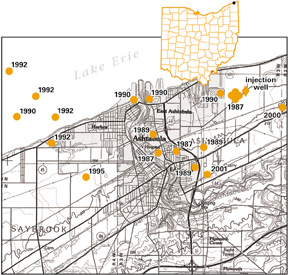Geotimes

News
Notes
Earthquake Studies
Triggering
quakes with waste
Seismologists believe that
millions of gallons of hazardous waste injected  nine
years ago into a 1.8 kilometer-deep well are leaking into the surrounding
rock pores and causing local earthquakes in Ashtabula Township, Ohio. The
liquid waste was injected under high pressure into the well from 1986 to
1993. The fluid naturally found pores and cracks to fill, but in this case
seems to have given an ancient unknown fault the lubrication necessary
to slip.
nine
years ago into a 1.8 kilometer-deep well are leaking into the surrounding
rock pores and causing local earthquakes in Ashtabula Township, Ohio. The
liquid waste was injected under high pressure into the well from 1986 to
1993. The fluid naturally found pores and cracks to fill, but in this case
seems to have given an ancient unknown fault the lubrication necessary
to slip.
The industrial port city
on Lake Erie experienced its first known earthquake swarm about a year
after the well began receiving waste. Before that time, no record existed
of an earthquake ever striking within 30 kilometers of the township. Then
a magnitude-3.8 quake with multiple aftershocks struck on July 13, 1987.
John Armbruster and Leonardo Seeber, both of the Lamont-Doherty Earth Observatory
at Columbia University in Palisades, N.Y., immediately started investigating
the earthquakes and determined the epicenters were only 700 meters from
the well.
Epicenter locations for earthquakes
greater than magnitude 2.0 in Ashtabula, Ohio, from 1987 through 2001.
Courtesy of the Ohio Department of Natural Resources.
They discovered a previously
unknown strike-slip fault at a depth of about 2 kilometers. Now, they say,
the injected fluids have migrated further from the well and are triggering
the slip of a second fault, about 4.5 kilometers away but still around
2 kilometers deep.
“The injection well is of
concern because it reaches the depth where earthquakes can occur,” Seeber
says. “About one mile down, the rock formation becomes permeable and fluid
migrating out from the well alters the pore pressure.” This weakens the
fault and triggers an earthquake, he says.
While most of the earthquakes
following the 1987 event had a magnitude less than 3.0, on Jan. 25, 2001,
a temblor of magnitude 4.5 shook the township. “That did damage to 50 homes
and businesses,” says geologist Michael Hansen of the Ohio Department of
Natural Resources. “Ceiling tiles fell, plaster cracked and gas lines broke
causing people to evacuate. Since 1987 we had felt predominately smaller
ones and this one brought Ashtabula into focus again.”
Ashtabula is not the first
example where fluids under high pressure put deep into the earth have induced
earthquakes. The classic case occurred in the 1960s at the Rocky Mountain
Arsenal near Denver, Colo. The Army pumped 165 million gallons of fluid
waste over a four-year period into a well about 3.7 kilometers deep. The
seismic records showed swarms of small earthquakes whose frequencies correlated
with the volume of fluid pumped each month. “The Army stopped using the
well because of the earthquakes and the largest event, in the magnitude
5 range, occurred after they stopped,” Seeber says. Eventually the seismic
activity subsided.
It’s difficult to determine
when an injection well may pressure a fault to slip. “There are a number
of injection wells in Ohio. And elsewhere companies are injecting hazardous
waste as deep as they can get it in the sedimentary rock, into the basement
and away from drinking water sources,” Hansen says. “In most cases it’s
never a problem. Indeed, I haven’t seen it in any other injection well
in Ohio.”
Beginning in 1989, after
federal restrictions prohibited dumping hazardous wastes on land, companies
like Environmental Resources Service, which drilled the Ashtabula well,
had to prove that anything injected into the ground stayed in place for
10,000 years. Before granting operating permits, the Ohio Environmental
Protection Agency at this time also began evaluating each site to determine
if it needed seismic monitoring.
Still, injection wells aren’t
the only culprits. The potential for an earthquake exists any time that
humans change the stress or pressure of the rocks at depth, Seeber says.
Pumping fluid into the earth, operating rock quarries or deep oil
wells are also likely activities known to trigger earthquakes around the
world, he says. “It’s not easy to investigate the situation. The first
thing we need to do is realize this is a problem and assess it and face
it. Yes, we need oil and mineral resources, and it is necessary to pump
fluids in and out of the ground. But we need to recognize that earthquakes
are a byproduct.”
Christina Reed
 nine
years ago into a 1.8 kilometer-deep well are leaking into the surrounding
rock pores and causing local earthquakes in Ashtabula Township, Ohio. The
liquid waste was injected under high pressure into the well from 1986 to
1993. The fluid naturally found pores and cracks to fill, but in this case
seems to have given an ancient unknown fault the lubrication necessary
to slip.
nine
years ago into a 1.8 kilometer-deep well are leaking into the surrounding
rock pores and causing local earthquakes in Ashtabula Township, Ohio. The
liquid waste was injected under high pressure into the well from 1986 to
1993. The fluid naturally found pores and cracks to fill, but in this case
seems to have given an ancient unknown fault the lubrication necessary
to slip.

